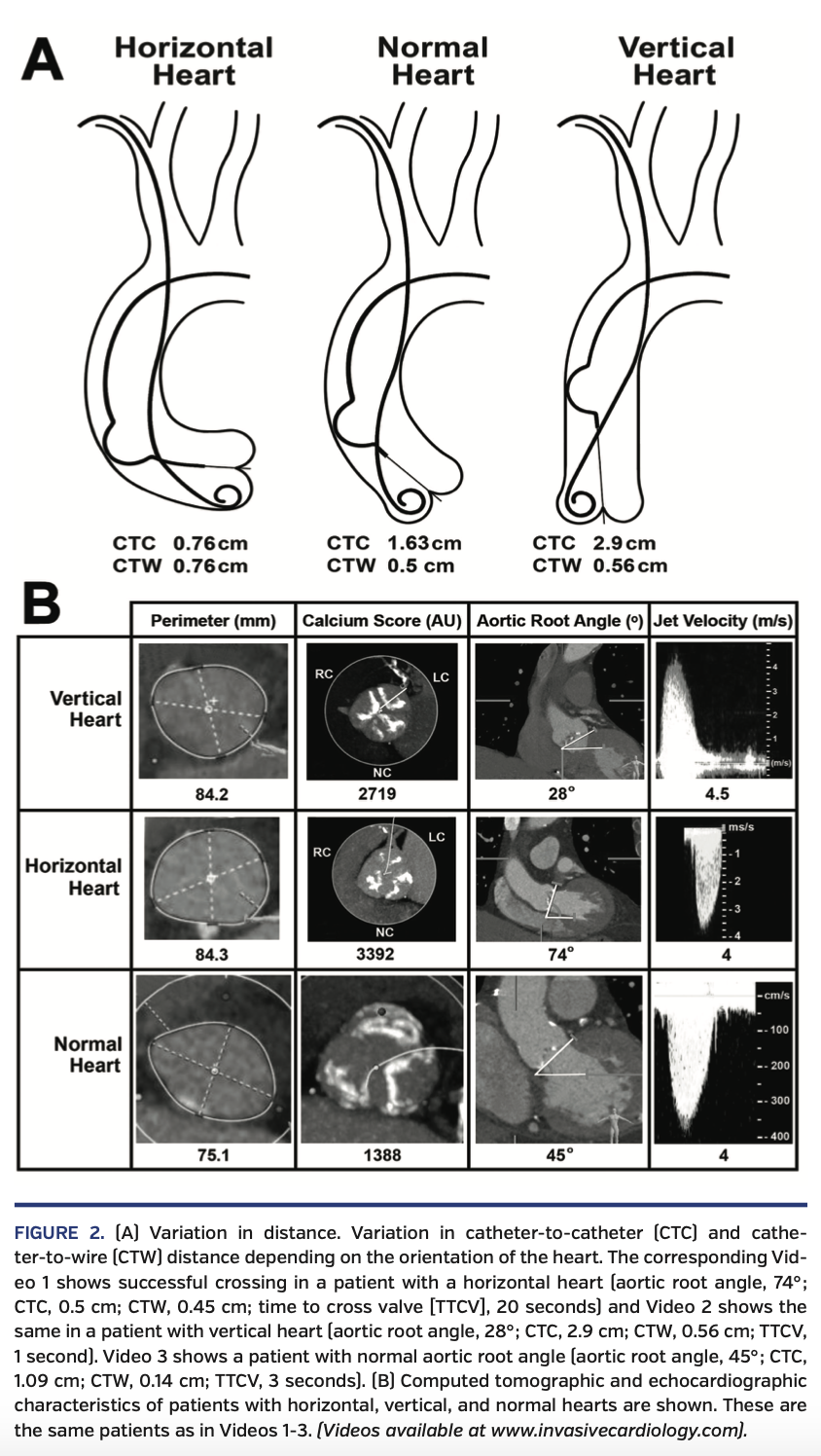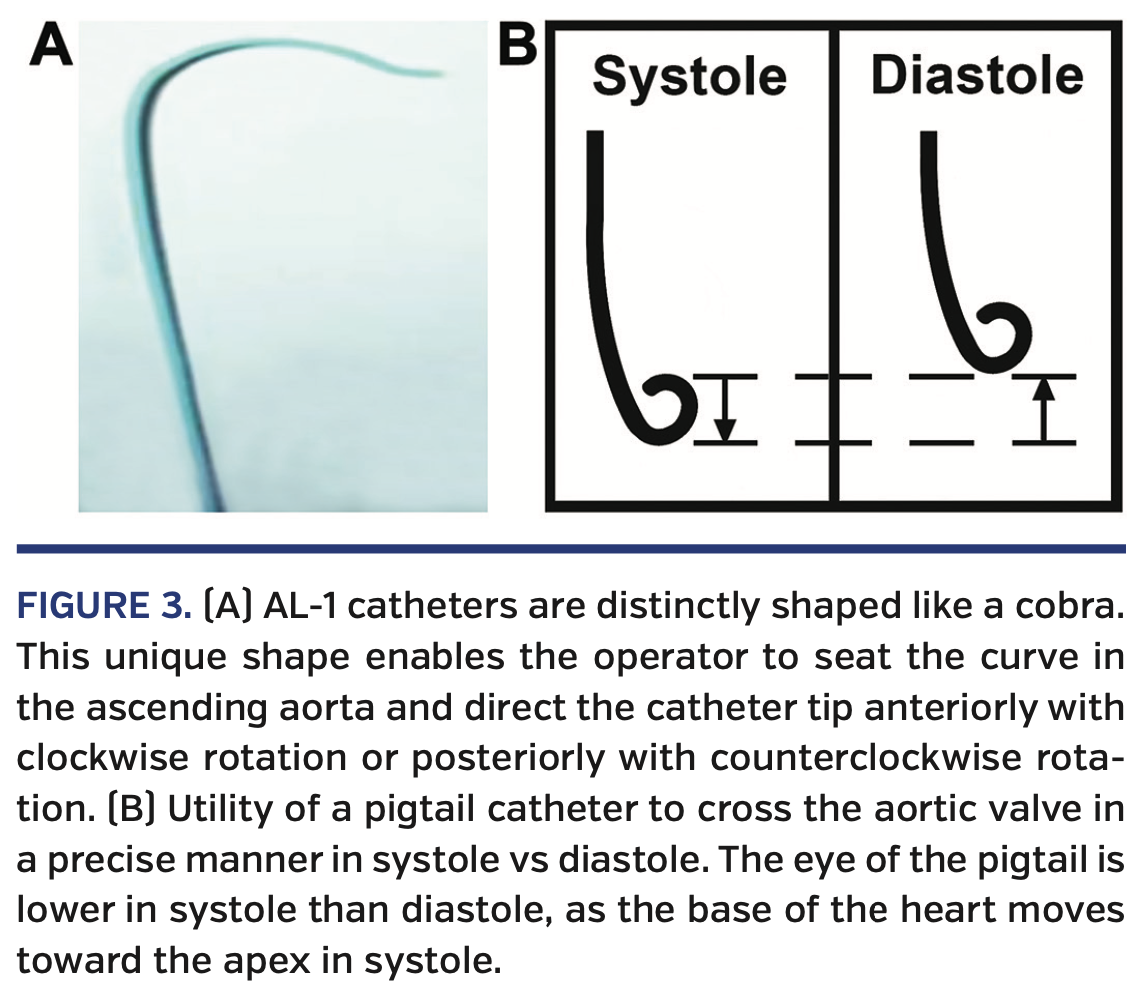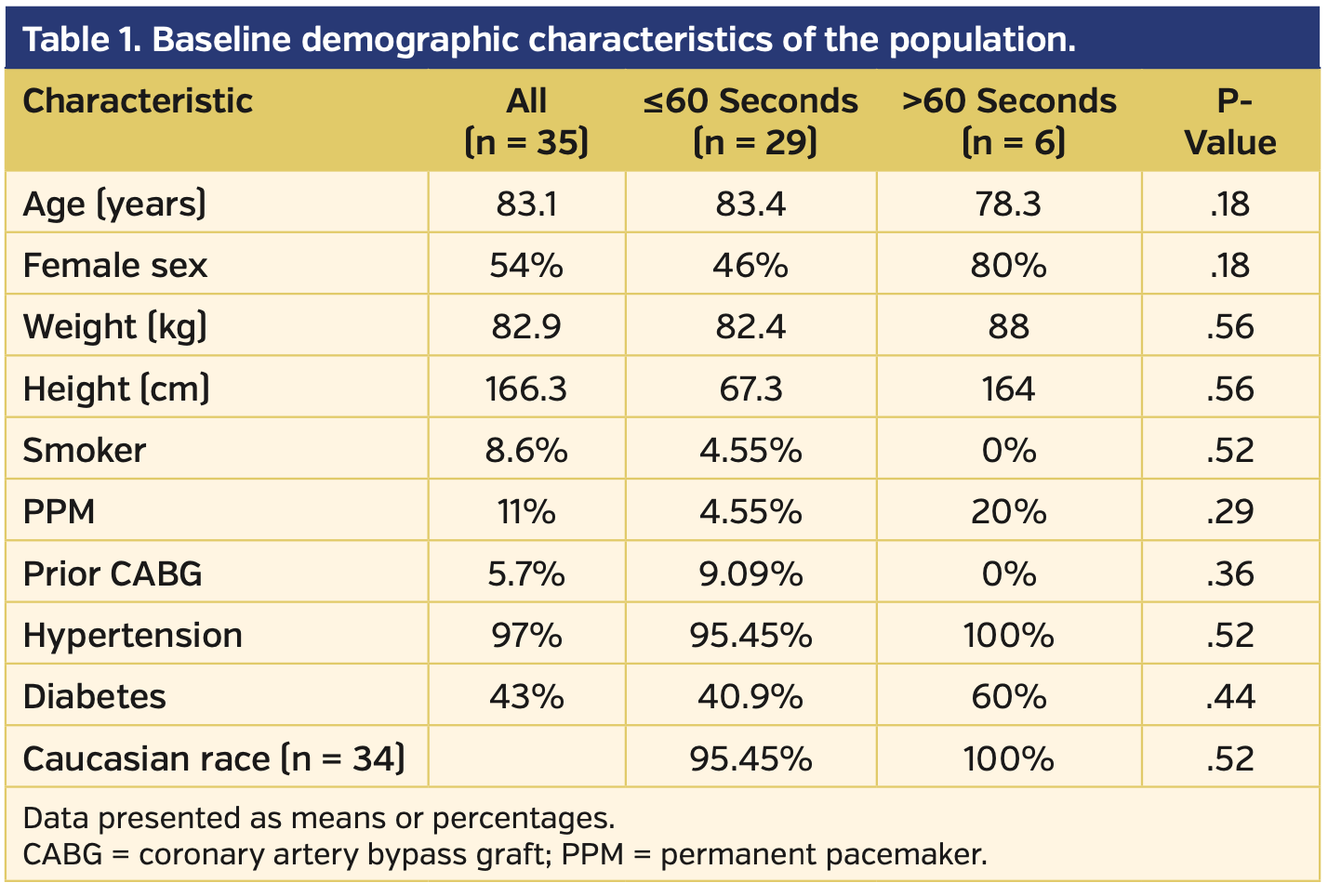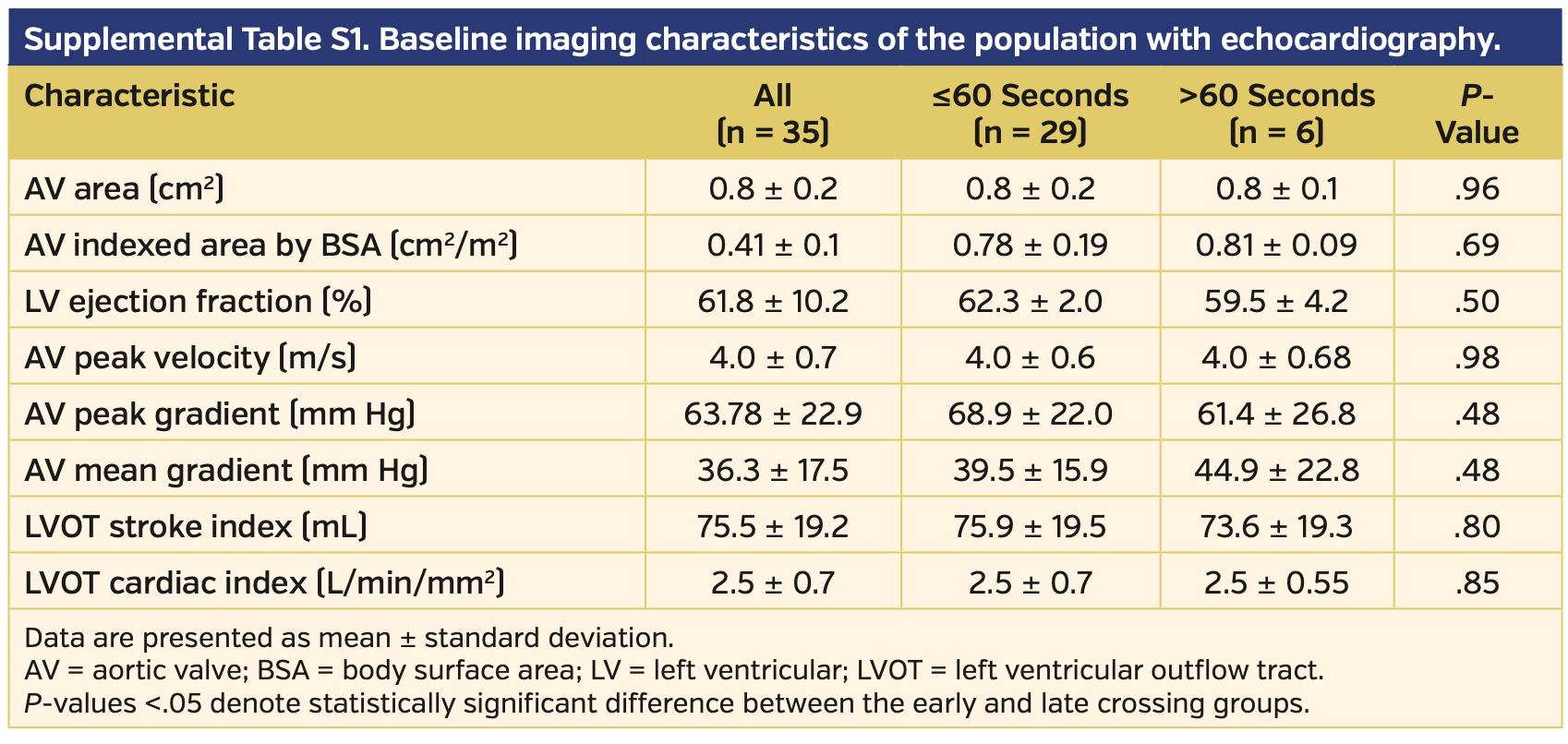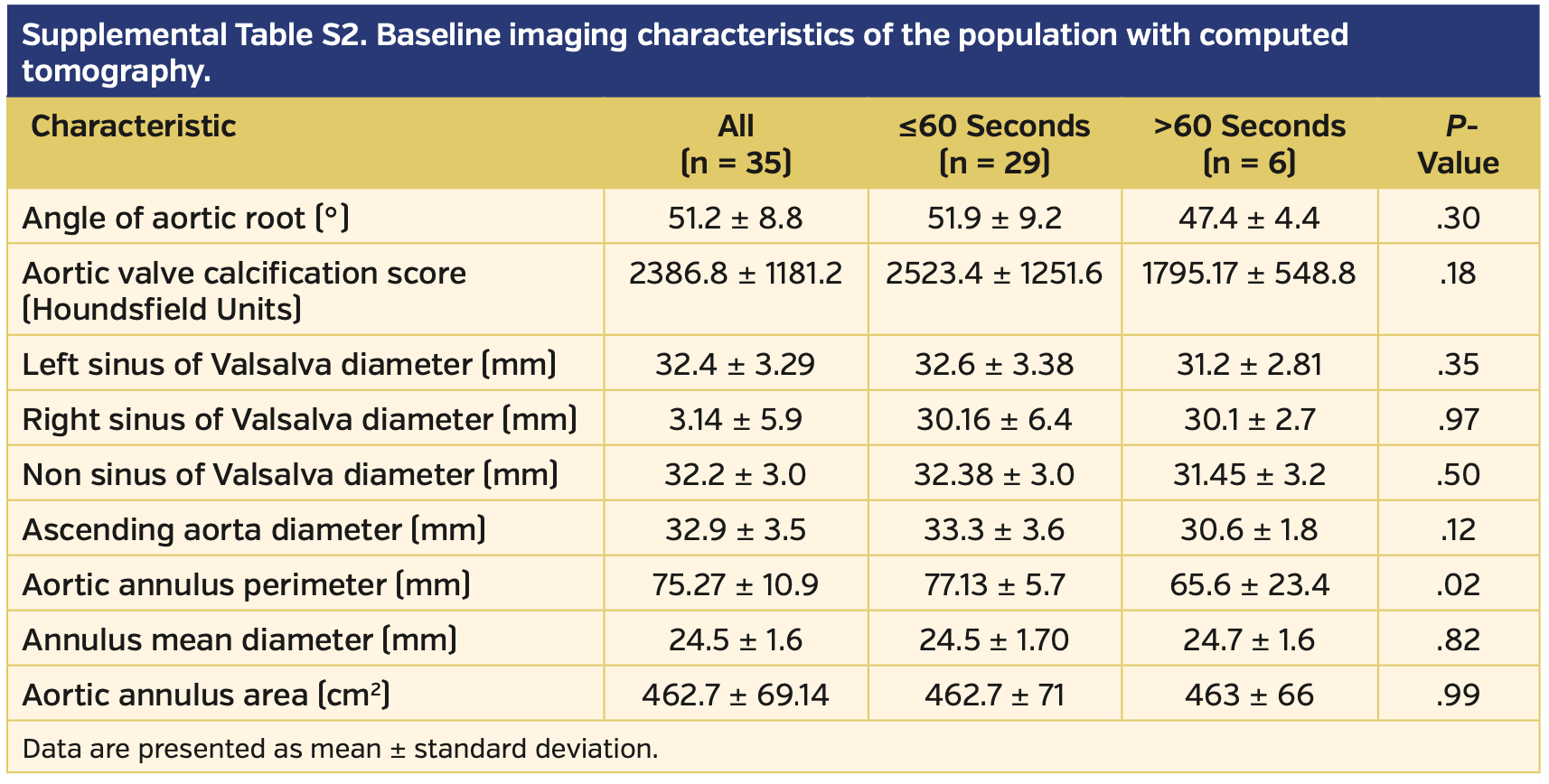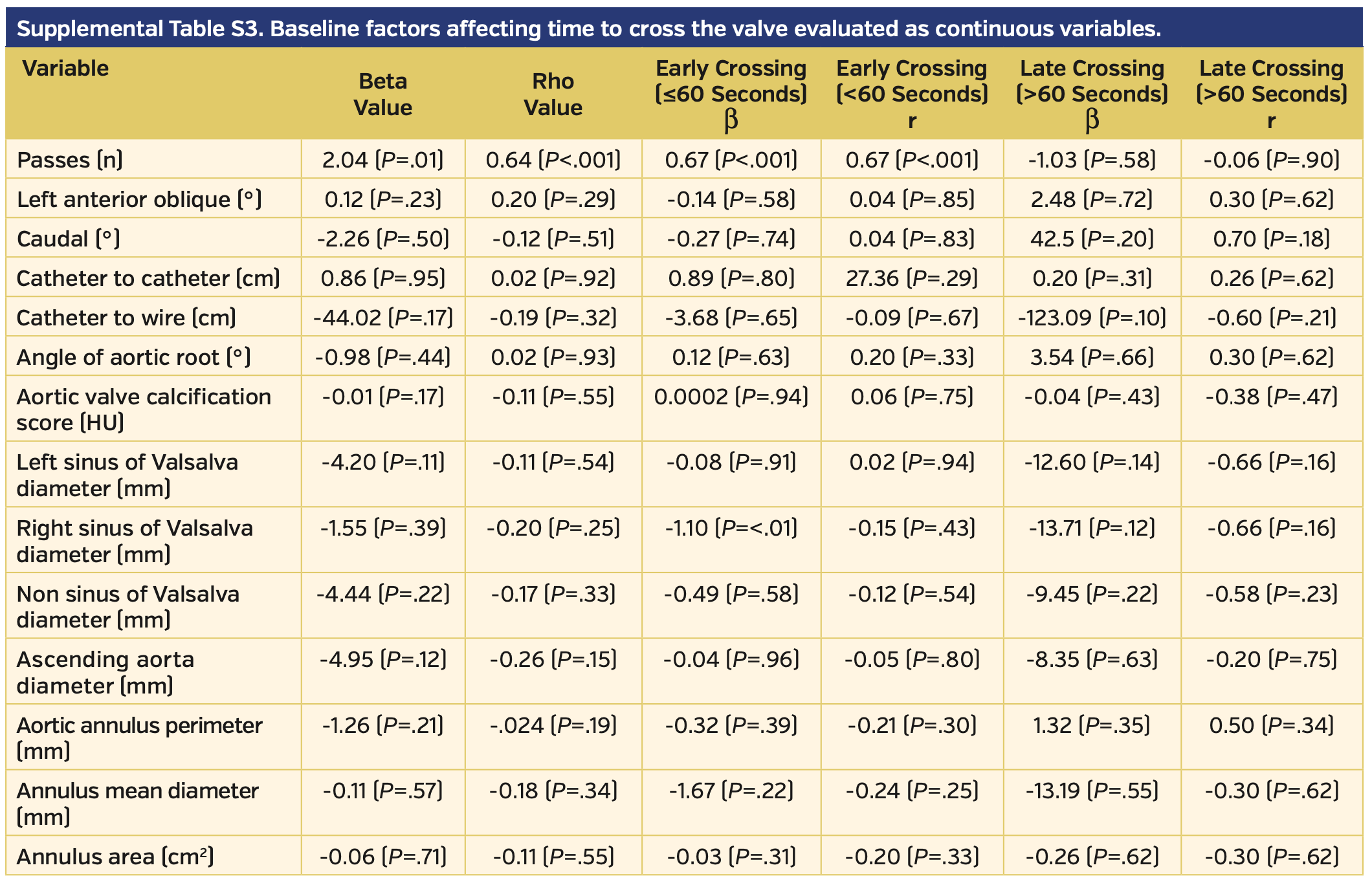Insights From Modern Imaging and Catheter Wire Measurements in Patients Undergoing Transcatheter Aortic Valve Replacement
Abstract: Background. Prior studies have neither described methods for crossing a severely stenotic aortic valve (AV) in light of modern imaging modalities (echocardiography, computed tomography, fluoroscopy) nor characterized a successful crossing. This study aimed to fill that gap. Methods. Time to cross the valve (TTCV) was measured prospectively in 35 consecutive patients undergoing transcatheter AV replacement and used to define two groups (≤60 seconds or >60 seconds). TTCV was analyzed as a function of 20 imaging variables. The AV was crossed systematically with a pigtail catheter parked in the non-coronary cusp, AL-1 catheter above the AV, and a straight wire for crossing, in 20° left anterior oblique view, as the operator adjusted catheter-to-catheter (CTC; AL-1 to pigtail) and catheter-to-wire (CTW; pigtail to wire) with each failed pass. Results. Mean TTCV was 39.5 ± 59 seconds. Of all the imaging variables, only lower AV peak velocity (3.9 ± 0.69 m/s vs 4.28 ± 0.35 m/s; P<.05) and larger aortic annulus perimeter (77 ± 5.7 mm vs 65 ± 23 mm; P<.05) were significantly different in the <60 group (n = 29; TTCV, 21 ± 12 seconds) vs the >60 group (n = 6; TTCV, 157 ± 52 seconds). The successful pass was characterized by a CTC of 1.67 ± 0.78 cm and CTW of 0.2 ± 0.36 cm. These distances increased in horizontal hearts (CTC and CTW were 0.76 cm) to higher in normally oriented hearts (CTC, 1.63 cm; CTW, 0.5 cm) to even higher in vertical hearts (CTC, 2.9 cm; CTW, 0.56 cm). Conclusion. Although lower peak jet velocity was associated with rapid AV crossing, the major insight from these data is characterization of a successful pass, which can facilitate clinical practice.
Key words: contemporary era, crossing time, physician technique, severely stenotic aortic valve, TAVR
Transcatheter aortic valve replacement (TAVR) has nearly replaced surgical aortic valve (AV) replacement as the treatment of choice for severe symptomatic aortic stenosis in the contemporary era.1 This improvement can be attributed to revision of valve designs by manufacturers, utilization of superior deployment techniques to reduce post-TAVR regurgitation and reduce pacemaker implantation rates,2 and use of cerebral protection devices to prevent strokes.3
The incidence of clinical strokes varies between 1% and 3% for valve crossing alone4 or during TAVR in multiple studies; however, the incidence of subclinical strokes (magnetic resonance imaging only) increases to 25% for valve crossing alone and 68%-93% after TAVR.4-6 A likely mechanistic explanation is that wire-valve interaction during an attempt to cross the highly stenotic AV leads to embolization of calcific debris to the brain, resulting in a stroke. Other mechanisms include a thrombus at the arch of the aorta that embolizes as a result of mechanical stimuli from catheters, wires, and valves. Because of the comorbidities associated with strokes, whether clinical or subclinical, there is continued interest within the structural heart disease community in devising new ways to reduce the incidence of stroke.
Studies that have described AV crossing predate the TAVR era,6-11 with only two studies published in the modern TAVR era.12,13 There are no previous data-driven studies to provide insight into the development of better techniques. Although prior studies have described methods for crossing a severely stenotic AV, none incorporated modern imaging modalities to further investigate the complexities in this process or systematically characterized a successful pass across the valve. This study was carried out to fill this gap in knowledge by: (1) incorporating data from modern imaging modalities, ie, computed tomography (CT) and echocardiography, in developing insights regarding the time to cross the valve (TTCV); and (2) prospectively saving the entire AV crossing attempt on fluoroscopy in order to characterize a successful crossing.
Methods
This study was approved by the Aurora St. Luke’s Medical Center institutional review board. Written informed consent was obtained from all patients.
Population sampling and data collection. We prospectively measured the TTCV in 35 consecutive patients undergoing TAVR between June 4, 2018 and July 30, 2018, and divided them into two groups (≤60 seconds, quick; >60 seconds, slow). TTCV was analyzed as a function of multiple (20 in all) standard fluoroscopy, CT, and echocardiographic variables. Owing to storage space limitations, the maximum length of fluoroscopic images was 60 seconds. Attempts lasting longer than 60 seconds were recorded in the medical record by a scribe. Fluoroscopic images were analyzed using Prosolv (Fujifilm). The TTCV was calculated based on the temporal resolution of fluoroscopy (15 frames/second); therefore 15 frames were counted as 1 second.
Methods of AV crossing. The AV was crossed, systematically, with a pigtail catheter parked in the non-coronary cusp (NCC), an AL-1 catheter above the AV, and a straight soft Glidewire (Terumo Interventional Systems) for crossing, in a 20° left anterior oblique view, as the operator adjusted catheter-to-catheter (CTC) and catheter-to-wire (CTW) distances with each failed pass. At our institution, the pigtail catheter is placed in the NCC, which is used as a reference point for valve implantation because it represents the lowest and right-most cusp and defines the inferior-most plane of the native AV. Then, an attempt is made to cross the valve by maneuvering the catheter-wire assembly. If the soft Glidewire fails, it is then exchanged with a straight stiff Glidewire. A successful pass was characterized by the pass that resulted in the crossing of the valve by the wire into the left ventricle.
For the purpose of characterization of a successful pass, two terms were coined. CTC distance was defined as the distance between the tip of the AL-1 catheter and the pigtail catheter’s superior margin (Figure 1A). CTW distance was defined as the distance between the outer margin of the pigtail catheter and the wire as it successfully crossed the valve. These distances were measured only for the successful pass, which was defined as the pass in which the wire successfully crossed the AV into the ventricle.
Distance measurement data. The CTC and CTW of all successful crosses were systematically measured in all 35 TAVR patients (Figure 1A). In addition, the crossing was characterized to be in systole or diastole based on pigtail and cardiac motions. The pigtail is housed in the NCC, which moves toward the apex, ie, downward, with each systole. In addition, the epicardial surface of the heart moves inward with each systole.
CT data. AV anatomical data were measured utilizing 3mensio software (Pie Medical Imaging). Analysis of CT data for each patient was performed by a Medtronic representative prior to TAVR. The measurements taken were: angle of aortic root; sinus of Valsalva diameter, measured separately from the right, left, and non-coronary sinuses; ascending aorta diameter; aortic annulus perimeter; aortic annulus mean diameter; annulus area; and aortic valve area (Figure 1B).
Echocardiographic data. Patients underwent echocardiography prior to TAVR, and the echocardiograms were read by three dedicated TAVR echocardiologists. From these reports, left ventricular ejection fraction (LVEF), AV peak velocity, AV peak gradient, AV mean gradient, left ventricular outflow tract (LVOT) stroke volume, and LVOT cardiac index were recorded.
Statistical analysis. Categorical data are summarized as a percentage of the group total with the corresponding 95% confidence interval (CI) based on normal approximation, and comparisons between groups are based on the Chi-squared test for association. Continuous variables are summarized as mean ± standard deviation, and comparisons between groups are based on analysis of variance (ANOVA) models. TTCV was analyzed via linear regression (parameter estimate β:P-value) and correlation coefficient (Spearman r: a focus on successful CTC and successful CTW). Two-sided P-values <.05 were considered significant. Analyses were performed using JMP 10 (SAS Institute).
Results
Patient characteristics. Out of the 45 patients who underwent TAVR between June 4, 2018 and July 30, 2018, ten were excluded from the study because their patient records lacked a recorded crossing time and/or fluoroscopy-saved images of the crossing. Baseline characteristics of the resulting 35-patient study population are summarized in Table 1. The majority of the patients were Caucasian (97%), female (54%), and hypertensive (97%), with a minority being active smokers (9%) and on current dialysis (2%) (Table 1). All patients received Evolut R or Evolut Pro valves (Medtronic), as dictated by CT measurement of valve and femoral artery diameters.
Determinants of TTCV. The strongest correlation with TTCV was the number of passes (β=2.04; P=.01: r=0.64; P≤.001). The average number of passes was 14 ± 13. Other variables that approached statistical significance included aortic annulus perimeter with an inverse relationship to TTCV. The mean time to cross the severely stenotic aortic valve was 39.5 ± 59 seconds (95% of the valves were crossed in 59 seconds and 5% were crossed in 19 seconds). The majority of valves were crossed in 0 to 25 seconds.
In all patients, a successful pass was made in systole, as defined by the inward motion of ventricular endocardium.
Subgroup analysis for CT and echocardiographic determinants of TTCV. The entire patient population was divided into either a quick-crossing group (≤60 seconds) or a slow-crossing group (>60 seconds). The quick-crossing group (n = 29; TTCV, 21 ± 12 seconds) had a larger population than the slow-crossing group (n = 6; TTCV, 157 ± 52 seconds). The quick-crossing group exhibited larger aortic annulus perimeters than the slow-crossing group (77 ± 5.7 mm vs 65 ± 2.3 mm, respectively; P<.05) and lower AV peak velocities (3.9 ± 0.69 m/s vs 4.28 ± 0.35 m/s, respectively; P<.05), such that with each m/s increase in jet velocity, TTCV increased by 11 seconds (Figure 1C).
Other variables that showed a trend toward significance were mean gradient, ascending aorta diameter, and calcification score; the slow-crossing group had a smaller mean ascending aortic diameter (30 ± 3.7 mm vs 33 ± 3.2 mm), higher mean gradient (45 ± 16.2 mm Hg vs 34 ± 15.6 mm Hg), and lower calcification score (1795 ± 1181 AU vs 2523 ± 1055 AU) than the quick-crossing group. AV peak gradient was directly proportional to TTCV such that for each mm Hg, TTCV increased by 0.37 seconds. AV mean gradient was proportional to TTCV such that for each mm Hg, TTCV increased by 0.36 seconds.
CTC and CTW associations. A successful pass was characterized by a CTC of 1.67 ± 0.78 cm and CTW of 0.2 ± 0.36 cm. Out of the 20 imaging variables, the only two variables significantly associated with CTC were aortic root angle and indexed AV area. The aortic root angle was inversely associated with CTC (Figures 1D and 1E) and CTW such that these distances increased in horizontal hearts (CTC and CTW were both 0.76 cm) to greater in normally oriented hearts (n = 25; aortic root angle, 30°-60°; CTC, 1.63 cm; CTW, 0.5 cm), to even greater in vertical hearts (CTC, 2.9 cm; CTW, 0.56 cm). Figure 2 summarizes the fluoroscopy, CT, and echocardiographic findings of 3 patients with normal heart, vertical heart, and horizontal heart to illustrate the findings in a pictorial format.
Supplemental Tables S1-S6 show baseline imaging characteristics of the population with CT, baseline factors affecting TTCV evaluated as continuous variables, specific characteristics of late crossers, and factors affecting the number of passes to cross the valve. The statistically significant associations have already been described in the text above.
Discussion
These data provide the anticipated insight that lower peak jet velocity and larger aortic annulus perimeters were significantly associated with rapid AV crossing for the first time in the literature. The counterintuitive observation was that of almost all other imaging variables (CT and echocardiography), none had a strong statistically significant relationship. In addition, these are the first data in the literature to characterize a successful pass. These data suggest that instead of focusing on patient, echocardiographic, and CT characteristics, the operator may decrease the TTCV and achieve successful crossing by starting from an ideal CTC distance of 1.67 cm and CTW distance of 0.2 cm, and then adjust both distances with each unsuccessful pass, being mindful of aortic root angle as a significant determinant of ideal CTC distance (Figure 2).
Previous studies that describe AV crossing were primarily done in a pre-TAVR era (1980s),6-11 with only two studies published in the modern TAVR era.14 None of these studies were data driven in order to provide insight into the technical aspects of AV crossing (Table 2). All of these studies are opinion driven, with sample sizes ranging from 7 to 447. Each study utilizes different catheters and describes different techniques, but most utilize an AL-1 catheter and straight-tip wires, which is in consonance with our study. This catheter-wire assembly is optimal because the curve of the cobra-shaped AL-1 (Figure 3A) provides the flexibility to change the angle of approach and the straight-tip guidewire provides the ability to aim through the orifice, with its hydrophilic polymer coating making it easier to slide through a narrow, calcific orifice. We used a soft, straight Glidewire in most cases due to it being safer, but in some difficult-to-cross cases, we switched to a stiff straight Glidewire.
Anatomical markers to aid physicians in crossing the AV. There are different anatomical markers that can be used when crossing the AV and that are available to the operator, dynamically, on the fluoroscopy screen. In order to achieve the optimal CTC distance (1.6 cm) and CTW distance (0.2 cm), we felt that the most stable and standardized measurement would come from the loop of the pigtail (1.6 cm) and the thickness of 6 Fr catheters (0.2 cm). Other markers like vertebral height, intercostal space, rib thickness, etc, will vary from patient to patient.
Crossing in systole versus diastole. The fact that the passes were made only in a systolic frame makes mechanistic sense because one is trying to cross a very narrow orifice that opens only in systole. This observation can be put to use if the operator times each pass with systole so that advancement of the wire begins in diastole and the wire approaches the valve in systole (Figure 3B). This rhythmic dance requires hand-eye coordination (the hand controlling the catheter and the eye looking at the fluoroscopic image) and needs further characterization of systole vs diastole as there is no electrocardiogram tracing on the fluoroscopic screen. There are a few variables available on the same fluoroscopy screen, including the pigtail in the NCC and the left border of the heart. The left border of the heart reliably moves downward with each systole in all patients; however, the pigtail only moves down in systole reliably if it is deeply seated in the NCC so its movements align with the ventricular contraction. We feel that of all the variables available indicating systole vs diastole, the pigtail is theoretically the best marker since it is in the line of sight of the catheter-wire assembly.
Association of passes with TTCV. The mean number of passes it took to cross the valve was 14. In the majority of cases (75%), the successful pass was made within 24 passes, which appears to be a very low number. Unfortunately, this cannot be compared with other studies because they do not include measurements of this important variable. It is possible that the number of passes will correlate with the incidence of stroke and not the TTCV given that each pass stands to violate the AV and send embolic debris to the brain. This is beyond the scope of our study, because we did not perform magnetic resonance imaging on our patients.
A greater number of passes were made in the first 10 seconds than in the last 10 seconds. This suggests that as more time elapses, the number of passes per second decreases due to heightened cautiousness as the operator tries to visualize the valve’s three-dimensional anatomy and integrate the data acquired from the failure of prior passes. It likely is reflective of a normal human tendency.
Among all the variables, the only statistically significant observations found were in AV peak velocity, AV mean gradient, and AV peak gradient. All of these variables are consistent with a high velocity jet, which would mechanistically make the valve crossing harder because the jet can potentially deflect the crossing wire.
Between-group analyses. The slow-crossing group had a significantly smaller mean aortic annulus perimeter (66 mm) than the quick-crossing group (77 mm). The larger annulus perimeter of the quick-crossing group appeared to contribute to the 1-minute crossing time difference. The reasons are unclear, but may be related to increased maneuverability of the catheter-wire assembly in a larger-perimeter valve.
Additional variables that exhibited a trend toward significance were mean gradient, ascending aorta diameter, and calcium score, with slow-crossers having a smaller ascending aortic diameter, higher mean gradients, and lower calcium scores. The smaller ascending aorta diameter probably correlates with the smaller annulus perimeter described in the previous paragraph. Higher mean gradients and AV peak velocity are likely reflective of the severity of the aortic stenosis. Interestingly, the area of the AV does not correlate, which suggests that it is not just the size of the orifice that matters, but the velocity of the blood exiting through the orifice that the wire has to negotiate in order to cross the valve.
The mean plus 95% CI of the CTC was 1.69 (1.42-1.98), indicating that 95% of the time, if the CTC is between 1.4-1.98 cm, then the successful pass will be made. Therefore, 1.69 cm may be the ideal starting CTC distance. This is the basis of the ideal pass diagram (Figure 2A), in which we have displayed the ideal CTC.
The range of CTC was 0-3.5 cm, indicating the needed flexibility if one does not cross the valve at the starting point; in this case, be ready to move in either direction from 1.69 cm to either double the distance or bring it close to zero. In our experience, these changes are made with slow rotations of the AL-1 catheter and slight advances or withdrawals, as larger movements are often counterproductive. In our experience, the best method has been to start the attempt to cross the valve by placing the AL-1 in an ideal position depending on the aortic root angle (Figure 2A). Although sometimes, based on this strategy, we have crossed the valve in a single pass, generally each failed pass defines the aortic valve anatomy in a dynamic way. Then, clockwise rotation moves the assembly anteriorly and counterclockwise rotation moves its posteriorly. In the vast majority of valves, the orifice is in the center, about 0.5 cm above the calcium in the leaflets, as noted by Judkins in 1982.17 The valve opening was always in the center of the valve, as illustrated by Videos 1 and 2 (same patients with horizontal and vertical hearts shown in Figure 2) showing the short-axis view of the aortic valve in two- and three-dimensional echocardiography.
Video 3 illustrates the phenomenon of valve crossing as we cross the valve in only three passes, and delivers the main message of this study, succinctly. In the first pass, the wire delineates the right coronary cusp. The operator rotates the catheter counterclockwise, and in the second pass the wire is deflected from the left coronary cusp. The third pass is successful as the operator partially clocks the catheter to aim at the center of the valve, which is right in between the right and left coronary cusp.
The length of the hoop of the pigtail is about 1.6 cm and is likely the ideal standardized marker for CTC, because there is no variability from patient to patient.
Study strengths and limitations. The strengths of the present study include the availability of medical records, systematic collection of data, standardized echocardiographic, CT, and fluoroscopic measurements, and a detailed data-driven analysis, providing data-driven insights, which is in contrast to prior studies that provided experiential opinion-driven insights. The limitations of this study include a small sample size, various physicians performing the TAVR procedures, and limited fluoroscopic storage.
Conclusion
This multi-imaging modality study on AV crossing suggested two echocardiographic variables, two CT variables, and two fluoroscopic variables that appear to enhance our understanding of this procedure. The echocardiographic variables include velocity; eg, the higher the velocity, the longer the TTCV. The CT variables are valve perimeter and aortic root angle, such that smaller perimeter was associated with longer TTCV and aortic root angle provided the foundation for categorization of the two fluoroscopic variables, CTC and CTW, which were used to characterize a successful pass.
In the future, a larger sample size, separate analysis of different AV crossing methods, magnetic resonance imaging examinations prior to and after TAVR, biplane imaging, and performance of aortic root angiogram to define the location of the orifice can all assist in further refinement of the observations made in this study.
From the Aurora Cardiovascular and Thoracic Services, Aurora Sinai/Aurora St. Luke’s Medical Centers, Milwaukee, Wisconsin.
Disclosure: The authors have completed and returned the ICMJE Form for Disclosure of Potential Conflicts of Interest. The authors report no conflicts of interest regarding the content herein.
Manuscript submitted December 2, 2019 and final version accepted December 11, 2019.
Address for correspondence: Khawaja Afzal Ammar, MD, Aurora Cardiovascular and Thoracic Services, 2801 W. Kinnickinnic River, Parkway, Ste. 880, Milwaukee, WI 53215. Email: publishing28@aurora.org
- Cribier A. The development of transcatheter aortic valve replacement (TAVR). Glob Cardiol Sci Pract. 2016;2016:e201632.
- Vahanian A, Alfieri OR, Al-Attar N, et al. Transcatheter valve implantation for patients with aortic stenosis: a position statement from the European Association of Cardio-Thoracic Surgery (EACTS) and the European Society of Cardiology (ESC), in collaboration with the European Association of Percutaneous Cardiovascular Interventions (EAPCI). Eur J Cardiothorac Surg. 2008;34:1-8.
- Vlastra W, Vendrik J, Koch KT, Baan J, Piek JJ, Delewi R. Cerebral protection devices during transcatheter aortic valve implantation. Trends Cardiovasc Med. 2018;28:412-418.
- Go AS, Mozaffarian D, Roger VL, et al. Heart disease and stroke statistics — 2013 update: a report from the American Heart Association. Circulation. 2013;127:e6-e245.
- Sundt TM, Bailey MS, Moon MR, et al. Quality of life after aortic valve replacement at the age of >80 years. Circulation. 2000;102:III70-III74.
- Crochet D, de Laguerenne J, Petitier H. New preshaped catheter for investigation of aortic stenosis by femoral approach: a study of 100 cases. Cathet Cardiovasc Diagn. 1980;6:337-343.
- Laskey WK, Untereker WJ, Kusiak V, Martin JL, Groh WC, Hirshfeld JW Jr. A safe and rapid technique for retrograde catheterization of the left ventricle in aortic stenosis. Cathet Cardiovasc Diagn. 1982;8:429-435.
- Harrison JK, Davidson CJ, Phillips HR, Harding MB, Kisslo KB, Bashore TM. A rapid, effective technique for retrograde crossing of valvular aortic stenosis using standard coronary catheters. Cathet Cardiovasc Diagn. 1990;21:51-54.
- Macdonald RG, Feldman RL, Pepine CJ. A modified catheter system for retrograde left ventricular catheterization in aortic valve stenosis. Cathet Cardiovasc Diagn. 1985;11:433-439.
- Chow JS, Wong PH, Lee PK, Wang RY, Chen WW. Percutaneous transfemoral catheterization in aortic stenosis with a USCI Sones catheter curve A type 1 (7540). Cathet Cardiovasc Diagn. 1985;11:201-206.
- O’Keefe JH Jr, Vlietstra RE, Hanley PC, Seward JB. Revival of the transseptal approach for catheterization of the left atrium and ventricle. Mayo Clin Proc. 1985;60:790-795.
- Omran H, Schmidt H, Hackenbroch M, et al. Silent and apparent cerebral embolism after retrograde catheterisation of the aortic valve in valvular stenosis: a prospective, randomised study. Lancet. 2003;361:1241-1246.
- Ropers D, Arnold M, Mundkowski D, et al. Prevalence of silent cerebral microembolism after cardiac catheterization of patients with high-grade aortic stenosis (Abstr). J Am Coll Cardiol. 2010;55:E1400.
- Sanghvi K, Pancholy S, Patel T. Hemodynamic assessment of severe aortic stenosis via transradial approach is safe. J Invasive Cardiol. 2015;27:E308-E311.
- Little WC, Arciniegas JG, Mantle JA. A safe, rapid method of transfemoral retrograde left ventricular catheterization in valvular aortic stenosis. Cathet Cardiovasc Diagn. 1981;7:417-423.
- Feldman T, Carroll JD, Chiu YC. An improved catheter design for crossing stenosed aortic valves. Cathet Cardiovasc Diagn. 1989;16:279-283.
- Judkins MP, Judkins E. Coronary arteriography and left ventriculography: Judkins technique. In: King SB III, Douglas JSJ, eds. Coronary Arteriography and Angioplasty. New York, NY: McGraw-HIll Book Company. 1985:200.







